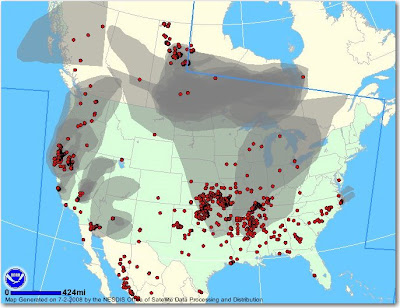HERE is a link to a pretty good map that shows most of the major fires in California, updated July 1 at 1900.
Author: Bill
Smoke–nationwide (almost)
On June 28 we posted a map that showed smoke plumes from California reaching east all the way to Missouri. Today there is even more smoke across the U.S. but most of it is not from the California fires. It originates in Canada, California, Kansas, Oklahoma, Arkansas, and Mississippi.
On the map below, the red dots are fires and the gray areas are smoke.
California: Piute fire
The Piute fire south of Lake Isabella was very active on Tuesday.
Information about the fire from South Zone, at 1800, July 1:
11,514 acres, 11% contained. Extreme conditions led to high rates of spread and torching. This resulted in significant eastward movement in Division X. The fire remained active throughout the Operational Period. Long-range spotting continues to be a dominant factor in fire progression. Growth potential continues to be high.
The map below shows heat, in red, orange, and black, detected by satellites last night, with the red areas being the most recently burned. The yellow lines are the perimeters uploaded by the incident management teams yesterday. Click on the map to see a larger version.
California: Basin fire update, July 2
The Basin Complex near Big Sur continues to spread on the north, east and south sides. Firefighters are requiring a mandatory evacuation on the west side of the fire for both sides of Highway 1 from Partington Ridge Road to 1 mile south of Limekiln State Park effective at 5:00 p.m. Tuesday, July 1, to provide for the safety of residents and firefighters while crews conduct a burning operation that will reinforce containment lines on the south end of the fire.
One place they are conducting firing operations is on the south side along the North Coast Ridge Trail. They are burning along a fireline that will connect the Basin complex to the Indians fire along that trail and the Rodeo Flats trail.
Here is the latest map, showing heat detected by satellites (in black, orange, and red), and the perimeter (in yellow) uploaded by the incident management team. Click on it to see a larger version.

The firing operation on the Indians fire is complete, and official containment is predicted for July 3.
California: Martin Mars on Lime Complex
The Martin Mars air tanker, which holds 7,200 gallons, made 5 drops on the Lime Complex and the Motion fire on Tuesday. It scooped the water out of Lake Shasta. Aerial firefighting in northern California has been very limited for the last 2 days due to poor visibility caused by smoke from the fires.
A total of 8 MAFFS air tankers, C-130’s from the military, are now assigned, working out of McClellan near Sacramento.

AZ: Firefighter Killed In Private Medical Helicopter Collision
Two medical helicopters collided on Sunday while trying to land at the same hospital, killing six, with one of them being a wildland firefighter that had been working on a fire in Grand Canyon National Park.
From the National Park Service Morning Report:
Firefighter Michael MacDonald was tragically killed in a private medical helicopter collision while being transported from the Grand Canyon to a northern Arizona hospital for a medical condition not directly related to firefighting on Sunday, June 29th. Six people, including MacDonald, were killed in the collision of two medical helicopters near Flagstaff Medical Center.
MacDonald, 26, was a member of the Chief Mountain Hot Shots, an elite Bureau of Indian Affairs-funded Native American firefighting crew based on the Blackfeet Indian Reservation in Browning, Montana. The crew was assigned to the Walla Valley Fire on the North Rim. The Chief Mountain Hot Shot crew will be released from the incident today to travel home.
From the Associated Press:
Two medical helicopters collided Sunday about a half-mile from a northern Arizona hospital, killing six people and critically injuring a nurse, a federal official said. Two emergency workers on the ground were injured after the crash.
One of the helicopters was operated by Air Methods out of Englewood, Colo., and the other was from Classic Helicopters of Woods Cross, Utah. Both aircraft were Bell 407 models, said Ian Gregor, a spokesman with the Federal Aviation Administration.
After the collision, the helicopters crashed in a wooded area east of Flagstaff Medical Center and started a 10-acre brush fire. An explosion on one of the aircraft after the crash injured two emergency workers who arrived with a ground ambulance company. They suffered minor burns, but their injuries were not life-threatening, authorities said.
“Crazy chaos, just lots of twisted metal wrapped up around people,” Capt. Mark Johnson, a spokesman for the Flagstaff Fire Department, said near the crash site.
Three people on the Air Methods aircraft, including the patient, died. On the Classic helicopter, the pilot, paramedic and patient all died. A flight nurse on the Classic helicopter was in critical condition at Flagstaff Medical Center.
“It’s just a very unfortunate tragedy,” said Matt Stein, a program director and lead pilot with Classic Helicopters subsidiary Classic Lifeguard Aeromedical Services in Page, Ariz.
Stein said his company’s crew was landing at Flagstaff Medical Center carrying a patient with a medical emergency from the Grand Canyon’s South Rim.
“We’ve been in business 20 years, and these are the first fatalities we’ve experienced,” Stein said. “They were all heroes. They were out doing a great service for their communities.”
Stein said the pilot for Classic was experienced with more than 10,000 hours of flight time. He added that it’s rare for two medical helicopters to attempt to land at a hospital at the same time.


